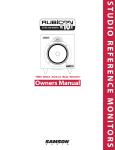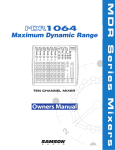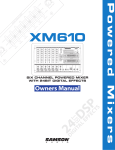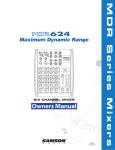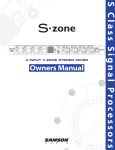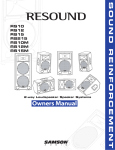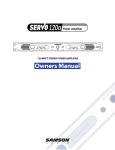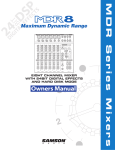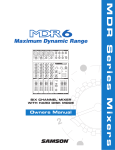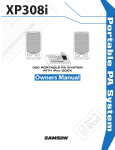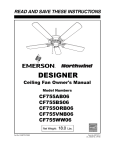Download Samson S Class Specifications
Transcript
S Class Signal Processors STEREO/MONO CROSSOVER Safety Instructions/Consignes de sécurité/Sicherheitsvorkehrungen/Instrucciones de seguridad WARNING: To reduce the risk of fire or electric shock, do not expose this unit to rain or moisture. To reduce the hazard of electrical shock, do not remove cover or back. No user serviceable parts inside. Please refer all servicing to qualified personnel.The lightning flash with an arrowhead symbol within an equilateral triangle, is intended to alert the user to the presence of uninsulated "dangerous voltage" within the products enclosure that may be of sufficient magnitude to constitute a risk of electric shock to persons. The exclamation point within an equilateral triangle is intended to alert the user to the presence of important operating and maintenance (servicing) instructions in the literature accompanying the product. Important Safety Instructions 1. Please read all instructions before operating the unit. 2. Keep these instructions for future reference. 3. Please heed all safety warnings. 4. Follow manufacturers instructions. 5. Do not use this unit near water or moisture. 6. Clean only with a damp cloth. 7. Do not block any of the ventilation openings. Install in accordance with the manufacturers instructions. 8. Do not install near any heat sources such as radiators, heat registers, stoves, or other apparatus (including amplifiers) that produce heat. 9. Do not defeat the safety purpose of the polarized or grounding-type plug. A polarized plug has two blades with one wider than the other. A grounding type plug has two blades and a third grounding prong. The wide blade or third prong is provided for your safety. When the provided plug does not fit your outlet, consult an electrician for replacement of the obsolete outlet. 10. Protect the power cord from being walked on and pinched particularly at plugs, convenience receptacles and at the point at which they exit from the unit. 11. Unplug this unit during lightning storms or when unused for long periods of time. 12. Refer all servicing to qualified personnel. Servicing is required when the unit has been damaged in any way, such as power supply cord or plug damage, or if liquid has been spilled or objects have fallen into the unit, the unit has been exposed to rain or moisture, does not operate normally, or has been dropped. ATTENTION: Pour éviter tout risque d’électrocution ou d’incendie, ne pas exposer cet appareil à la pluie ou à l’humidité. Pour éviter tout risque d’électrocution, ne pas ôter le couvercle ou le dos du boîtier. Cet appareil ne contient aucune pièce remplaçable par l'utilisateur. Confiez toutes les réparations à un personnel qualifié. Le signe avec un éclair dans un triangle prévient l’utilisateur de la présence d’une tension dangereuse et non isolée dans l’appareil. Cette tension constitue un risque d’électrocution. Le signe avec un point d’exclamation dans un triangle prévient l’utilisateur d’instructions importantes relatives à l’utilisation et à la maintenance du produit. Consignes de sécurité importantes 1. Veuillez lire toutes les instructions avant d’utiliser l’appareil. 2. Conserver ces instructions pour toute lecture ultérieure. 3. Lisez avec attention toutes les consignes de sécurité. 4. Suivez les instructions du fabricant. 5. Ne pas utiliser cet appareil près d’une source liquide ou dans un lieu humide. 6. Nettoyez l’appareil uniquement avec un tissu humide. 7. Veillez à ne pas obstruer les fentes prévues pour la ventilation de l’appareil. Installez l’appareil selon les instructions du fabricant. 8. Ne pas installer près d’une source de chaleur (radiateurs, etc.) ou de tout équipement susceptible de générer de la chaleur (amplificateurs de puissance par exemple). 9. Ne pas retirer la terre du cordon secteur ou de la prise murale. Les fiches canadiennes avec polarisation (avec une lame plus large) ne doivent pas être modifiées. Si votre prise murale ne correspond pas au modèle fourni, consultez votre électricien. 10. Protégez le cordon secteur contre tous les dommages possibles (pincement, tension, torsion,, etc.). Veillez à ce que le cordon secteur soit libre, en particulier à sa sortie du boîtier. 11. Déconnectez l’appareil du secteur en présence d’orage ou lors de périodes d’inutilisation prolongées. 12. Consultez un service de réparation qualifié pour tout dysfonctionnement (dommage sur le cordon secteur, baisse de performances, exposition à la pluie, projection liquide dans l’appareil, introduction d’un objet dans le boîtier, etc.). ACHTUNG: Um die Gefahr eines Brandes oder Stromschlags zu verringern, sollten Sie dieses Gerät weder Regen noch Feuchtigkeit aussetzen.Um die Gefahr eines Stromschlags zu verringern, sollten Sie weder Deckel noch Rückwand des Geräts entfernen. Im Innern befinden sich keine Teile, die vom Anwender gewartet werden können. Überlassen Sie die Wartung qualifiziertem PRECAUCION: Para reducir el riesgo de incendios o descargas, no permita que este aparato quede expuesto a la lluvia o la humedad. Para reducir el riesgo de descarga eléctrica, nunca quite la tapa ni el chasis. Dentro del aparato no hay piezas susceptibles de ser reparadas por el usuario. Dirija cualquier reparación al servicio técnico oficial. El símbolo del relámpago dentro del triángulo equilátero pretende advertir al usuario de la presencia de “voltajes peligrosos” no aislados dentro de la carcasa del producto, que pueden ser de la magnitud suficiente como para constituir un riesgo de descarga eléctrica a las personas. El símbolo de exclamación dentro del triángulo equilátero quiere advertirle de la existencia de importantes instrucciones de manejo y mantenimiento (reparaciones) en los documentos que se adjuntan con este aparato. Instrucciones importantes de seguridad 1. Lea todo este manual de instrucciones antes de comenzar a usar la unidad. 2. Conserve estas instrucciones para cualquier consulta en el futuro. 3. Cumpla con todo lo indicado en las precauciones de seguridad. 4. Observe y siga todas las instrucciones del fabricante. 5. Nunca utilice este aparato cerca del agua o en lugares húmedos. 6. Limpie este aparato solo con un trapo suave y ligeramente humedecido. 7. No bloquee ninguna de las aberturas de ventilación. Instale este aparato de acuerdo a las instrucciones del fabricante. 8. No instale este aparato cerca de fuentes de calor como radiadores, calentadores, hornos u otros aparatos (incluyendo amplificadores) que produzcan calor. 9. No anule el sistema de seguridad del enchufe de tipo polarizado o con toma de tierra. Un enchufe polarizado tiene dos bornes, uno más ancho que el otro. Uno con toma de tierra tiene dos bornes normales y un tercero para la conexión a tierra. El borne ancho o el tercero se incluyen como medida de seguridad. Cuando el enchufe no encaje en su salida de corriente, llame a un electricista para que le cambie su salida anticuada. 10. Evite que el cable de corriente quede en una posición en la que pueda ser pisado o aplastado, especialmente en los enchufes, receptáculos y en el punto en el que salen de la unidad. 11. Desconecte de la corriente este aparato durante las tormentas eléctricas o cuando no lo vaya a usar durante un periodo de tiempo largo. 12. Dirija cualquier posible reparación solo al servicio técnico oficial. Deberá hacer que su aparato sea reparado cuando esté dañado de alguna forma, como si el cable de corriente o el enchufe están dañados, o si se han derramado líquidos o se ha introducido algún objeto dentro de la unidad, si esta ha quedado expuesta a la lluvia o la humedad, si no funciona normalmente o si ha caído al suelo. Fachpersonal.Der Blitz mit Pfeilspitze im gleichseitigen Dreieck soll den Anwender vor nichtisolierter “gefährlicher Spannung” im Geräteinnern warnen. Diese Spannung kann so hoch sein, dass die Gefahr eines Stromschlags besteht. Das Ausrufezeichen im gleichseitigen Dreieck soll den Anwender auf wichtige Bedienungs- und Wartungsanleitungen aufmerksam machen, die im mitgelieferten Informationsmaterial näher beschrieben werden. Wichtige Sicherheitsvorkehrungen 1. Lesen Sie alle Anleitungen, bevor Sie das Gerät in Betrieb nehmen. 2. Bewahren Sie diese Anleitungen für den späteren Gebrauch gut auf. 3. Bitte treffen Sie alle beschriebenen Sicherheitsvorkehrungen. 4. Befolgen Sie die Anleitungen des Herstellers. 5. Benutzen Sie das Gerät nicht in der Nähe von Wasser oder Feuchtigkeit. 6. Verwenden Sie zur Reinigung des Geräts nur ein feuchtes Tuch. 7. Blockieren Sie keine Belüftungsöffnungen. Nehmen Sie den Einbau des Geräts nur entsprechend den Anweisungen des Herstellers vor. 8. Bauen Sie das Gerät nicht in der Nähe von Wärmequellen wie Heizkörpern, Wärmeklappen, Öfen oder anderen Geräten (inklusive Verstärkern) ein, die Hitze erzeugen. 9. Setzen Sie die Sicherheitsfunktion des polarisierten oder geerdeten Steckers nicht außer Kraft. Ein polarisierter Stecker hat zwei flache, unterschiedlich breite Pole. Ein geerdeter Stecker hat zwei flache Pole und einen dritten Erdungsstift. Der breitere Pol oder der dritte Stift dient Ihrer Sicherheit. Wenn der vorhandene Stecker nicht in Ihre Steckdose passt, lassen Sie die veraltete Steckdose von einem Elektriker ersetzen. 10. Schützen Sie das Netzkabel dahingehend, dass niemand darüber laufen und es nicht geknickt werden kann. Achten Sie hierbei besonders auf Netzstecker, Mehrfachsteckdosen und den Kabelanschluss am Gerät. 11. Ziehen Sie den Netzstecker des Geräts bei Gewittern oder längeren Betriebspausen aus der Steckdose. 12. Überlassen Sie die Wartung qualifiziertem Fachpersonal. Eine Wartung ist notwendig, wenn das Gerät auf irgendeine Weise, beispielsweise am Kabel oder Netzstecker beschädigt wurde, oder wenn Flüssigkeiten oder Objekte in das Gerät gelangt sind, es Regen oder Feuchtigkeit ausgesetzt war, nicht mehr wie gewohnt betrieben werden kann oder fallen gelassen wurde. - Table of Contents Introduction 2 S•2-way Features 3 Controls and Functions Front Panel Layout Rear Panel Layout 4 5 Operating the S•2-Way Setting Up the S•2-way Setting up the S•2-way for Stereo 2-way Operation S•2-way Controls S 2•Way System Set-Ups Mono 3-way Operation SETTING UP THE S 2-way USING A REAL TIME ANALYZER 6 7-8 9 10 11 - 12 S•2-way Connections 13 Block Diagram 14 Specifications 15 Notes 16 s Copyright 2003, Samson Technologies Corp. Printed February, 2004 Samson Technologies Corp. 575 Underhill Blvd. P.O. Box 9031 Syosset, NY 11791-9031 Phone: 1-800-3-SAMSON (1-800-372-6766) Fax: 516-364-3888 www.samsontech.com Introduction Thank you for purchasing the Samson S 2-way electronic crossover. The Samson S 2-way is a one rack-space, dual channel electronic signal processor capable of managing frequency crossover for stereo 2-way and mono 3-way speaker systems. The S 2-way is an ideal crossover solution for small and large PA systems, live sound venues, commercial installations, recording studio monitors and DJ set-ups. The S 2-way is easy to configure for stereo or mono operation by using the front panel mode switch. In addition to its flexibility in configuring to different sound systems, the S 2-way has advanced features such as Delay control for time aligning speakers plus individual Phase and Mute switches for each frequency band. S 2way’s convenient meters and back-lit switches provide instant status of levels and important speaker management settings. Perhaps the best attribute of the S 2-way is its clean and transparent signal path, thanks to the advanced electronic design and the use of high quality components. The S 2-way is a complete electronic crossover solution, which will give you precise control and superior sound from your loudspeaker system. In these pages, you’ll find a detailed description of the features of the S 2-way electronic crossover, as well as a guided tour through its front and rear panels, step-by-step instructions for its setup and use, and full specifications. You’ll also find a warranty card enclosed—please don’t forget to fill it out and mail it in so that you can receive online technical support and so we can send you updated information about these and other Samson products in the future. With proper care and adequate air circulation, your S 2-way will operate trouble free for many years. We recommend you record your serial number in the space provided below for future reference. Serial number: Date of purchase: Should your unit ever require servicing, a Return Authorization number (RA) must be obtained before shipping your unit to Samson. Without this number, the unit will not be accepted. Please call Samson at 1-800-3SAMSON (1-800-372-6766) for a Return Authorization number prior to shipping your unit. Please retain the original packing materials and if possible, return the unit in the original carton and packing materials. 2 S 2-way Features The Samson S 2-way electronic crossover utilizes the latest technology in crossover filters and speaker management design. Here are some of its main features: • Full featured, Stereo 2-way, Mono 3-way electronic crossover. • Precision Linkwitz-Riley, 24 dB/Octave filters. • Each channel incorporates a High Pass Filter, Butterworth 25 Hz, 12 dB/Octave, to help you reduce stage rumble and the engery loss from sub-sonic frequencies. • For time aligning speaker stacks, each Low Frequency output can be delayed for phase correction by using the adjustable Delay control located on the front panel. • The X10 Range switch allows to adjust frequency range of the filter, allowing you to change from mid-band to high-band. • The four segment LED Input Gain meter allows you to monitor the signal level and make easy gain adjustment. • In the Master Control Section, there is a Mute switch for each of the individual outputs, allowing you to listen to the different sections of the speaker systems seperately. • Phase Switches are included in the Master Control Section to invert the phase of the individual outputs. • Servo balanced inputs and outputs on XLR connectors. • Pristine audio quality thanks to the advanced circuit design, utilizing low noise operational amplifiers and high quality VCAs. • High quality metal shaft pots and backlit switches. • The stylish, electric blue, alluminum front-panel is as easy to read as it is to look at. • Three-year extended warranty. 3 DELAY (CH 1) – This control is used to adjust the delay line from 0 to 2ms, for time aligning the low frequency output. LOW GAIN (CH 1) - Adjusts the output level of the LOW frequency band for the left in stereo 2-way mode, or for the LOW band in mono 3-way mode. FREQUENCY (CH 1) - This control sets the crossover point dividing the frequency bands from low-to-high in stereo 2-way mode, or from low-to-mid when you are operating in mono 3way mode. HIGH GAIN (CH 1) - Adjusts the output level of the HIGH frequency band for Channel 1 in stereo 2-way mode, or for the MID band in mono 3-way mode. PHASE Switch (MID / HIGH CH1) - Used to invert the phase on the left HIGH output in stereo 2-way mode, or the MID output in mono 3-way mode. MUTE Switch (MID / HIGH CH 1) - This switch is used to defeat the output for the HIGH frequency output when operating in stereo 2-way mode, or to defeat the MID frequency output when operating in mono 3-way mode. 4 5 6 7 8 20 6 3 5 INPUT METER (CH 1) – Four-segment LED VU meter displays the amount of level present at the Channel 1, or left, input. 4 2 3 INPUT GAIN - Used to adjust the input gain from –12dB to +12dB. 19 STEREO/MONO CROSSOVER 2 1 1 FRONT PANEL LAYOUT 9 MASTER CONTROLS 23 10 11 24 4 INPUT GAIN - Used to adjust the input level from –12dB to +12dB. DELAY (CH 2) – This control is used to adjust the delay line, from 0 to 2ms, for time aligning the channel 2 low frequency output. This control has no effect when operating in stereo 3-way mode. LOW GAIN CONTROL (CH 2) - Adjusts the output level of the LOW frequency band for right in stereo 2-way mode. This control has no effect when operating in stereo 3-way mode. FREQUENCY CONTROL (CH 2) - This control sets the crossover point dividing the frequency bands from lowto-high in stereo 2-way mode, or from mid-to-high when you are operating in mono 3-way mode. HIGH GAIN CONTROL (CH 2) - Adjusts the output level of the HIGH frequency band for Channel 2 in stereo 2way mode, or for the HIGH band in mono 3-way mode. 14 15 16 17 INPUT METER (CH 2) – Four-segment LED VU meter displays the amount of level present at the Channel 2, or lright input. 12 13 MUTE Switch (HIGH CH 2) - This switch is used to defeat the output for the HIGH frequency output when operating in stereo 2-way mode, or to defeat the HIGH frequency output when operating in mono 3-way mode PHASE Switch (HIGH CH2) - Used to invert the phase on the right HIGH output in stereo 2-way mode, or the HIGH output when operating in mono 3-way mode. OPERATING MODE SELECTOR - Selects one of the 2 operating modes, 2-way stereo or 3-way mono. 22 8 11 10 9 21 7 MUTE Switch (LOW CH1) - This switch is used to defeat the LOW frequency output when operating in stereo 2-way mode, or to defeat the LOW frequency output when operating in mono 3-way mode. PHASE Switch (LOW CH2) - Used to invert the phase on the right LOW output in stereo 2-way mode. This control has no effect when operating in stereo 3-way mode. MUTE Switch (LOW CH 2) - This switch is used to defeat the output for the right LOW frequency output when operating in stereo 2-way mode. This control has no effect when operating in stereo 3way mode. HPF Switch (CH2) - Engages the High Pass Filter, or low cut, rolling off the low frequencies at 25Hz, by12 dB per octave, helping to reduce unwanted low frequency rumble. This control has no effect when operating in stereo 3-way mode. RANGE Switch (CH 2)– This switch is used to change the frequency range of the crossover filter from 35 Hz to 800 Hz, or from 350 Hz to 8 kHz when the switch is engaged. 22 23 24 25 26 PHASE Switch (LOW CH1) - Used to invert the phase on the leftLOW output in stereo 2-way mode, or the LOW output when operating in mono 3-way mode. 21 18 RANGE Switch (CH 1)– This switch is used to change the frequency range of the crossover filter from 35 Hz to 800 Hz, or from 350 Hz to 8 kHz when the switch is engaged. 17 20 26 16 HPF Switch (CH1) - Engages the High Pass Filter, or low cut, rolling off the low frequencies at 25Hz, by12 dB per octave, helping to reduce unwanted low frequency rumble. 15 19 14 MAIN POWER Switch - When this switch is engaged, the green LED will illuminate indicating that the S 2-way is powered up and ready for operation. 25 13 18 12 Controls and Functions 5 D C B A CHANNEL 2 INPUT - XLR balanced line INput. output. CHANNEL 2 LOW OUTPUT - XLR balanced line PUT - XLR balanced line output. CHANNEL 2 HIGH OUTPUT?MONO HIGH OUT- tor with external fuse. AC INLET - IEC standard ac power cable connec- REAR PANEL LAYOUT G F E anced line input. CHANNEL 1 INPUT/MONO INPUT - XLR bal- PUT - XLR balanced line output. CHANNEL 1 LOW OUTPUT/MONO LOW OUT- PUT - XLR balanced line output. CHANNEL 1 HIGH OUTPUT/MONO MID OUT- Controls and Functions Operating the S 2-way SETTING UP THE S 2-way Whether you are an experienced audio engineer or just starting out, the following sections of this manual will help you get going with your S 2-way. Now that you have unpacked the unit and have become a bit familiar with the front panel controls, you can follow the next sections of this manual to begin to set-up and operate your new crossover. Further on in this manual, you will find detailed wiring diagrams of various speaker system set-ups. For detailed diagrams of connector and cable wiring, see page 13 in this manual. MODE SWITCH The S 2-way can be configured to operate in two modes including Stereo 2-way and Mono 3-way. The Mode Switch, located in the center section of the unit, is used to select one of the two operating modes. Notice that the outlined box around the ledged “3W” highlights the 3-way Mono position. If you operate the unit in 3-way mono mode, you will find that some of the functions change the band that the control. The 3-way parameters for these switches and control knobs are indicated by the outlined box. MONO 3-WAY INDICATORS Because the S 2-way can be configured to operate in either stereo 2-way or mono 3-way, the channel 1 crossover controls may be adjusted for the frequency division between low and high, or low and mid depending on the mode. On some crossovers, it is very difficult to get a quick visualization as to what controls are controlling what function. The S 2-way solves this problem by highlighting the function with the outlined box around the legend over Frequency and Gain controls. You will see the same indication for the Phase and Mute switches in the master section. These provide quick identification of the frequency band that is under control. In the diagram below, you can see what functions are under control when operating in mono 3-way mode. Channel One 1 FREQ 2 3 4 5 L/M MID MID MONO 3W Channel Two 6 M/H 7 FREQ Times 10 Frequencies (when RANGE switch is engaged). Crossover Low to Mid Mid Frequency GAIN control PHASE switch Operating mode switch Crossover Mid to High Times 10 Frequencies (when RANGE switch is engaged). 6 6 7 Operating the S 2-way SETTING UP THE S 2-way FOR STEREO 2-way OPERATION The following operating example is for a Stereo 2-way system using a 15" low frequency driver and a 1" compression driver on both the left and right sides. CAUTION: Before you apply power to your speaker system amplifiers, be certain to set the frequency controls to the manufacturers recommended crossover points for the drivers or enclosures you are using. NOTE: LAST ON / FIRST OFF When running a loudspeaker system with one or multiple power amplifiers, it is highly recommended that you follow the LAST ON / FIRST OFF rule. When powering up your sound system, turn your power amplifier on last. When you power down your system, turn your power amplifiers off first. This will prevent any switching spikes you may get from other gear in your system, and help prevent unnecessary pops that can sometimes cause speaker damage. • Connect both sets of inputs and outputs to the designated connectors on the rear panel. For a detailed cable-wiring diagram see page 13. * Set the controls to the following positions: INPUT GAIN DELAY LOW GAIN LOW/MID FREQUENCY RANGE SWITCH HIGH GAIN MODE SWITCH HIGH PHASE LOW PHASE HIGH MUTE LOW MUTE -12 0 -6 2.6 kHz IN -6 ST 2W OUT OUT IN IN • Set the controls for the S 2-way’s Channel 2 to the same positions. • Set the Power Switch to the ON position. • Connect the mixer’s left output to the S 2-way’s CH1 (Left) input and the mixer’s right output to the S 2way’s CH2 (Right) input. Next, connect the S 2-way’s CH1 (Left) Low Output to the left input of the power amp operating the low frequency drivers, and then, connect the CH1 High Output to the left input of the power amp operating the High frequency drivers. Now, make the same connections for the S 2way’s CH2(Right) and amplifiers right side. 7 Operating the S 2-way Once you have your system wired-up, follow the steps below: • Set the mode switch to the ST 2 W position. Notice the silkscreen BAND INDICATORs showing the frequencies that are now under control by the associated GAIN or FREQUENCY knobs. • Use the FREQUENCY control on Channel 1 and 2 to set the desired crossover point. • Lower your power amplifier outputs to all the way off. Turn on all your power amplifiers. Run an audio signal (like some music from a CD) through your mixer and raise the output faders until you see the Input Meter LED’s begin to light. • Slowly raise the S 2-way’s Input Gains until the Input Meters read 0dB. • Now raise your power amps to their normal operating level. • Slowly raise the S 2-way’s Ch1 (Left) Low Gain to 0 and then raise CH2 (Right) Low Gain to 0. • Slowly raise the S 2-way’s Ch1 (Left) High Gain to 0 and then raise CH2 (Right) HIGH Gain 0. • Now use an RTA (Real Time Analyzer), or an even more sophisticated piece of test gear, your ears, to adjust the balance between the low, (mid) and high end. You can continue to raise the Gain controls as you fine-tune the system. Watch the Peak Meters on your power amplifiers to ensure that you’re running a clean signal. 8 Operating the S 2-way S 2-way Controls The Samson S 2-way features a variety of control functions that offer the sound engineer advanced control over a speaker system. The next section is a description of the control functions and how they are used to improve the overall sound of a sound reinforcement system. HIGH PASS FILTER The S 2-way incorporates a HPF (High Pass Filter) which when engaged, activates a low frequency roll off at 25 Hz. By using the HPF, you eliminate the sub-sonic frequencies sent to the low frequency power amplifier. Since the amplifier will try to reproduce these frequencies when the HPF is off, in most cases the result is simply wasted energy. By using the S 2way HPF you send just the frequencies you want to reproduce to your low frequency amplifiers and speakers. DELAY The S 2-way features a delay that can be set for up to two milliseconds of delay time for time aligning speaker stacks. PHASE SWITCHES The S 2-way incorporates individual PHASE reversal switches on each frequency band. When engaged, the LED illuminates indicating that the selected output is now 180 degrees out of phase. MUTE SWITCHES The S 2-way features Mute switches on each frequency band. When engaged, the LED illuminates and that channel output is turned off. The MUTE switches are convenient for trouble shooting or for simply listening to each speaker section separately. 9 S 2-way System Set-Ups MONO THREE WAY OPERATION If you’re operating your PA system Mono 3-way, wire your system as shown in the system diagram below. Once you have your system wired-up, follow the steps below: • Locate the MODE switch in the master section and set it to the MONO 3 W position. • Notice the outlined boxes showing the frequencies that are now under control by the associated GAIN or FREQUENCY knobs. • Now, use the first crossover FREQ on Channel 1 to set the desired frequency dividing the low and mid frequencies. • Next, set the frequency point dividing the mid and high by using Channel 2’s crossover FREQ control. • Now, adjust the first gain control on Channel 1 to set the level of the LOW frequency output. • Next, adjust the second gain control on Channel 1 to set the level of the MID frequency output. • Next, adjust the second gain control on Channel 2 to set the level of the HIGH frequency output. • You can use an RTA (Real Time Analyzer), or an even more sophisticated piece of test gear, your ears, to adjust the balance between the low, (mid) and high end. You can continue to raise the Gain controls as you fine-tune the system. Watch the Peak Meters on your power amplifiers to ensure that you’re running a clean signal. 10 SETTING UP THE S 2-way USING A REAL TIME ANALYZER SETTING UP THE S•2-way USING A REAL TIME ANALYZER A REAL TIME ANALYZER (RTA) is an especially useful tool for setting up your crossover, as it will enable you to set parameters like DELAY and LEVEL more accurately. Some Audio Engineers can use their ears to tune a loudspeaker system. Some will even use the crossover to create the over-all system curve by using the crossover like an equalizer. For the rest of us, an accurately set crossover with a flat response is the best way to start and using a RTA, like the Samson D1500, is the best way to get there. Using the RTA to Set DELAY Time. In the real world, no single or multiple speaker system is perfect. If there were such a perfect system, it would more than likely be comprised of a single transducer that alone could faithfully reproduce the entire frequency spectrum. Because no such system exists, we have to deal with the problems associated with multiple transducers. The first problem that you will encounter, whether you know it or not, is time travel. That’s when the S 2-way’s delay circuit becomes especially useful. Ideally, the sound reproduced by each driver in the loudspeaker system would be traveling through the air ultimately reaching the listeners at the same time. To accomplish this in a system using multiple drivers or enclosures, the voice coils of all the drivers would have to be lined up on the same vertical axis. This is very difficult to achieve in many cases because of the physical size of the different components, and the position of the drivers in their enclosures. It is not uncommon to have a physical distance of 2” to 24" or more between the low and high frequency drivers. For example, front loaded low frequency drivers and compression drivers mounted on a large horn. With no correction, the low frequency signal can be traveling through the air 2" to 24" in front of the high frequencies and thereby reaching the listeners at different times. Although the delay time between the low and high frequency signal may be relatively small, the negative effects can be substantial. The problem is that both drivers are reproducing frequencies at and around the crossover point, which arrive at the listeners at different times. Typically, the resulting problem is comb filtering or cancellations at the crossover frequencies. Using delay greatly helps to improve phasing problems (especially with low frequency drivers) and will help you achieve a tighter, punchy low end response. The S 2-way features a DELAY control allowing you to dial up to 2 milliseconds of delay. By using an RTA and the S 2-way’s DELAY, you can time align the drivers in your system and minimize the possibilities of comb filtering. Now follow these steps, separately, for both the left and rights sides of your loudspeaker: • Set the crossover to the desired frequencies and press all the Mute switches to the ON position, turning all of the S 2-ways outputs off. Position your measurement microphone approximately 15 feet from your loudspeaker array, halfway between the low and high frequency drivers. Now turn all the GAIN controls to the fully counter clockwise position. • Play a sine wave tuned to the crossover frequency, or connect a pink noise generator to your loudspeaker system either from your mixer or in the S 2-way’s input. Now turn off the Low Frequency Mute switch and adjust the S 2-way’s INPUT GAIN to "0”. Adjust the LOW GAIN control so that the signal is playing at a loud, but not too painful level. Make sure you only hear sound from the low frequency driver. • Adjust the level control of the RTA until it reads OdB at the crossover frequency. Now press the LOW MUTE switch turning off the low frequency output. 11 SETTING UP THE S 2-way USING A REAL TIME ANALYZER • Turn off the High Frequency MUTE switch and turn up the High Frequency Level control until the RTA reads 0dB at the crossover frequency. • Now, press the LOW MUTE switch again turning on the low frequency output. Notice the reading on the RTA at the crossover frequency. If the reading is 0dB, there is no need to adjust the delay time and you can assume that the speakers are in phase. If the RTA reads less than +3dB you’ll need to delay the low frequency. • While watching the RTA display, slowly turn the DELAY control counter-clockwise until the display reads as close to +0dB as possible. Setting the GAIN Controls Using a RTA It is critical to set the GAIN output controls so that all the frequency bands combine to create an over-all flat system response. Using an RTA to set the GAIN control will make it much easier for you to accomplish a flat system response. Follow the steps below, separately for each side of your system, to set the GAIN controls using an RTA. • With the crossover set to the desired frequencies, press all the Mute switches to the ON position, turning all of the S 2-way’s outputs off. Be sure that all of the PHASE switches are out (LED’s off). Position your measurement microphone approximately 15 feet from your loudspeaker array at a level ranging from your chest to your ear. Now turn all the GAIN controls to the fully counter clockwise position. • Play a sine wave tuned to the crossover frequency, or connect the signal from a pink noise generator to your loudspeaker system, either from your mixer or directly in the S 2-way’s input. Now turn off the Low Frequency Mute switch and adjust the S 2-way’s INPUT GAIN to "0’. • Adjust the LOW GAIN control until the RTA has an average reading of -3dB at and below the frequency of the LOW crossover point. • Engage the LOW Mute. • Next, play a sine wave tuned to the crossover frequency, or connect the signal from a pink noise generator to your loudspeaker system, either from your mixer or directly in the S 2-way’s input. Now turn off the HIGH Frequency Mute switch. • Adjust the HIGH GAIN control until the RTA has an average reading of -3dB at and above the frequency of the HIGH crossover point. • Engage the HIGH mute and turn off the mute in the LOW frequency output. Check to see if the RTA is still showing -3dB at the crossover point. Remember the High frequency output is also set for -3dB out put, and since both the high and low frequency outputs are set to a level of -3dB at the crossover point, the summed signal level will be 0dB. Note: If you have trouble making the measurements as described above, be sure to check the position of the PHASE switches, and also, check your balanced wiring for proper phase. For a detailed cable-wiring diagram see page 13. At this point all of the frequency bands will be at the same level and your system will have a flat response. After setting the levels you can use a graphic equalizer, like the Samson S curve 231 or D 2500, if you want set a particular response curve to tune the speaker system for a specific sound. 12 Connections Unbalanced 1/4” Connector Balanced TRS 1/4” Connector XLR Balanced Wiring Guide 13 Block Diagram 14 Specifications Inputs Female Balanced XLR Impedance Balanced Max. Input level >15k Ohms +26dBu balanced Outputs Male Balanced XLR Impedance Balanced Max. Output Level 100 Ohms +26 dBu Global Specifications Frequency Response <10 Hz to >90 kHz, +0/-3 dB Signal to Noise (Ref +4 dBu), 22 Hz to 22 kHz, un-weighted 90dB high out, mid 90dB, low 94dB, all outs >100dB muted CMRR Min.40dB, >55 dB @ 1 kHz Crossover Crossover Type Crossover 1 Channel 1 Linkwitz-Riley, 24 dB/Octave 35 to 800Hz 350 to 8kHz / with 10X multiplier Crossover 1 Channel 2 35 to 800Hz 350 to 8kHz / with 10X multiplier Function Switches Front Panel High Pass Filter Mute Phase -3dB @ 25Hz 2 pole, 12dB/Octave For individual outputs Inverts the phase of the individual output Power Supply Mains Voltages USA/Canada Mains Voltages Europe Power Consumption Power Inlet 105-125 VAC ~, 60 Hz 215 – 254 VAC~,50Hz 14 Watts Standard IEC receptacle / with Fuse Physical Dimensions Net Weight Shipping Weight 1 3/4" (44,5 mm) * 19" (482,6 mm) * 8 1/2" (217 mm) 6.6lbs., (3 kg) 9.4lbs., (4,3 kg) 15 Notes 16 Samson Technologies Corp. 575 Underhill Blvd. P.O. Box 9031 Syosset, NY 11791-9031 Phone: 1-800-3-SAMSON (1-800-372-6766) Fax: 516-364-3888 www.samsontech.com




















